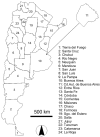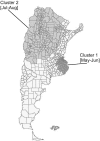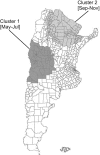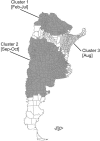Spatiotemporal trends of cases of pandemic influenza A(H1N1)pdm09 in Argentina, 2009-2012
- PMID: 25923892
- PMCID: PMC4435011
- DOI: 10.1590/S0036-46652015000200006
Spatiotemporal trends of cases of pandemic influenza A(H1N1)pdm09 in Argentina, 2009-2012
Abstract
The aim of this paper was to analyze the spatiotemporal variations of cases of influenza A(H1N1)pdm09 in Argentina. A space-time permutation scan statistic was performed to test the non-randomness in the interaction between space and time in reported influenza A(H1N1)pdm09 cases. In 2009, two clusters were recorded in the east of Buenos Aires Province (May and June) and in the central and northern part of Argentina (July and August). Between 2011 and 2012, clusters near areas bordering other countries were registered. Within the clusters, in 2009, the high notification rates were first observed in the school-age population and then extended to the older population (15-59 years). From 2011 onwards, higher rates of reported cases of influenza A(H1N1)pdm09 occurred in children under five years in center of the country. Two stages of transmission of influenza A(H1N1)pdm09 can be characterized. The first stage had high rates of notification and a possible interaction with individuals from other countries in the major cities of Argentina (pattern of hierarchy), and the second stage had an increased interaction in some border areas without a clear pattern of hierarchy. These results suggest the need for greater coordination in the Southern Cone countries, in order to implement joint prevention and vaccination policies.
El objetivo de este trabajo es analizar las variaciones espaciotemporales de los casos de gripe A(H1N1)pdm09 en Argentina. Se realizó un escaneo estadístico espacio-temporal por permutaciones para poner a prueba la no aleatoriedad en la interacción entre espacio y tiempo de los casos registrados de gripe A(H1N1)pdm09. Durante 2009 se identificaron dos conglomerados espacio-temporales, en el este de la provincia de Buenos Aires (mayo y junio) y en la mayor parte del centro-norte de la Argentina (julio y agosto). Durante 2011 y 2012 se registraron conglomerados próximos a zonas limítrofes con otros países. Al interior de los conglomerados, primero se observaron mayores tasas de notificación en población de edad escolar para luego extenderse a población mayor (15-59 años). A partir de 2011, las mayores tasas se observaron en menores de 5 años residentes en el centro del país. Se pudieron caracterizar dos etapas de transmisión espacio-temporal de la gripe A(H1N1)pdm09. La primera etapa se caracterizó por altas tasas de notificación y una posible interacción con individuos provenientes de otros países llegados a las grandes ciudades de la Argentina (patrón de jerarquía). La segunda etapa mostró una mayor interacción en algunas zonas fronterizas y sin un patrón claro de jerarquía. Estos resultados plantean la necesidad de generar una mayor coordinación en países del Cono Sur, con el objetivo de implementar políticas más efectivas de prevención y vacunación.
Figures




Similar articles
-
Pandemic influenza A/H1N1 2009 antibodies in the metropolitan area of Buenos Aires in Argentina.Int J Infect Dis. 2014 Feb;19:20-5. doi: 10.1016/j.ijid.2013.09.021. Epub 2013 Nov 6. Int J Infect Dis. 2014. PMID: 24211378
-
2009 Pandemic influenza A virus subtype H1N1 in Morocco, 2009-2010: epidemiology, transmissibility, and factors associated with fatal cases.J Infect Dis. 2012 Dec 15;206 Suppl 1(Suppl 1):S94-100. doi: 10.1093/infdis/jis547. J Infect Dis. 2012. PMID: 23169979 Free PMC article.
-
Incidence and epidemiology of hospitalized influenza cases in rural Thailand during the influenza A (H1N1)pdm09 pandemic, 2009-2010.PLoS One. 2012;7(11):e48609. doi: 10.1371/journal.pone.0048609. Epub 2012 Nov 6. PLoS One. 2012. PMID: 23139802 Free PMC article.
-
Influenza A(H1N1)pdm09 epidemiology in the Eastern Province of Saudi Arabia.J Infect Public Health. 2018 Sep-Oct;11(5):636-639. doi: 10.1016/j.jiph.2018.05.014. Epub 2018 Jun 21. J Infect Public Health. 2018. PMID: 29937408 Free PMC article.
-
Impact of influenza in the post-pandemic phase: Clinical features in hospitalized patients with influenza A (H1N1) pdm09 and H3N2 viruses, during 2013 in Santa Fe, Argentina.J Med Virol. 2017 Jul;89(7):1186-1191. doi: 10.1002/jmv.24758. Epub 2017 Feb 16. J Med Virol. 2017. PMID: 28004402
Cited by
-
Prospective study of avian influenza H9 infection in commercial poultry farms of Punjab Province and Islamabad Capital Territory, Pakistan.Trop Anim Health Prod. 2017 Jan;49(1):213-220. doi: 10.1007/s11250-016-1159-6. Epub 2016 Oct 20. Trop Anim Health Prod. 2017. PMID: 27761776 Free PMC article.
References
-
- Alexander FE, Cuzick J. Methods for the assessment of disease clusters. In: Elliott P, Cuzick J, English D, Stern R, editors. Geographical environmental epidemiology. New York: Oxford University Press; 1992.
-
- Bandaranayake D, Jacobs M, Baker M, Hunt D, Wood T, Bissielo A, et al. The second wave of 2009 pandemic influenza A (H1N1) in New Zealand, January-October 2010. Euro Surveill. 2011;16: - PubMed
-
- Ellis J, Galiano M, Pebody R, Lackenby A, Thompson C, Bermingham A, et al. Virological analysis of fatal influenza cases in the United Kingdom during the early wave of influenza in winter 2010/11. Euro Surveill. 2011;16: - PubMed
MeSH terms
LinkOut - more resources
Full Text Sources
Medical

